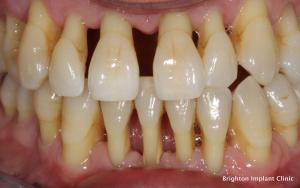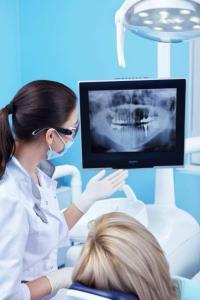 Periodontal Disease is the most prevalent chronic disease in the world. Periodontal Disease also called Gum Disease is the leading cause of tooth loss. Gum disease starts when normal oral bacteria forms on teeth where the gum line meets teeth. In response to bacteria accumulating at the gum line, the gums become inflamed. The initial phase of the disease characterized by swollen gums is called Gingivitis. During “Gingivitis” the bacterial accumulations are above the gum line. Gingivitis progresses to Periodontitis when bacteria eat away the gum attachment to the teeth and move down below the gum line where they wreck havoc and eat away tooth-supporting bone. So there you have it, Periodontal Disease is that simple or is it?
Periodontal Disease is the most prevalent chronic disease in the world. Periodontal Disease also called Gum Disease is the leading cause of tooth loss. Gum disease starts when normal oral bacteria forms on teeth where the gum line meets teeth. In response to bacteria accumulating at the gum line, the gums become inflamed. The initial phase of the disease characterized by swollen gums is called Gingivitis. During “Gingivitis” the bacterial accumulations are above the gum line. Gingivitis progresses to Periodontitis when bacteria eat away the gum attachment to the teeth and move down below the gum line where they wreck havoc and eat away tooth-supporting bone. So there you have it, Periodontal Disease is that simple or is it?
Periodontal Disease is not simple, but rather it is more of a complex Autoimmune disease. When bacteria colonize (aka “Plaque” or “Tartar”) below the gum line they release Toxins and cause bone and gum inflammation. The bacteria and toxins also can enter into the blood stream through the thinner tissue below the gum line and cause or contribute to other systemic disease. During Gum disease progress, the immune system begins to turn against the teeth. The immune system initiates an attack on the teeth where the bone is resorbed from around the teeth and the teeth eventually get loose and fall out. Sometimes the disease attacks all the teeth, but often it is just some of the teeth. Periodontal disease does not affect all people all people the same way. In fact, some individuals with poor oral hygiene may get only a mild form of Gingivitis that never progresses to irreversible periodontitis. Periodontal disease, like many other autoimmune diseases, has a genetic component, as certain individuals are more likely to get it than others.
The Following Factors are known to affect Gum and Periodontal Disease:
- Tobacco Use
- Genetics
- Stress
- Medications
- Clenching and Grinding of Teeth
- Diabetes
- Poor Nutrition
Nutrition and Periodontal Health:
Diet is important in controlling periodontal disease because bacteria in your mouth use sugars for energy and reproduction. When oral hygiene is poor and the diet is high in sugar, there will be lots of growth of disease progressing bacteria. Stress is also a major factor. Stress + Sugar = lower acidity in the mouth and an increase in Gum Disease.
The human body needs vitamins and minerals to help regulate our metabolism. A diet high in fiber and fruits and vegetables will help reverse periodontal disease naturally. Essential Fatty Acids and Proteins provide the energy to help build vital cells. To reverse gum disease naturally, we to discipline ourselves to maintain healthier eating habits (stay away from processed foods) and keep stress to a minimum.
Supplements and Gum Disease:
Vitamin C
Vitamin C is an important vitamin for healthy gums. it appears to fight bacteria and promote the formation of new healthy gum tissue. Vitamin C also reduces inflammation and infection during the progression of periodontal disease. Vegetable high in Vitamin C include Oranges, Grapefruit, Tomatoes, Broccoli, Cauliflower, Cantaloupe, Strawberries and Asparagus.
Recommended daily dose of 1000mg 3x per day
CoQ10
30mg 3x per day
Vitamin A
10,000 I.U.
Vitamin E
400mg 1x per day
Calcium/Magnesium 2:1 ratio 200mg per day
Garlic
 Advantages of the Zeramex Zirconia Implant:
Advantages of the Zeramex Zirconia Implant:
